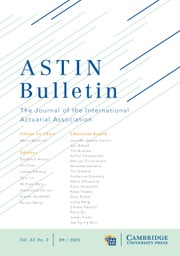Article contents
Worst-case moments under partial ambiguity
Published online by Cambridge University Press: 13 March 2023
Abstract
The model uncertainty issue is pervasive in virtually all applied fields but especially critical in insurance and finance. To hedge against the uncertainty of the underlying probability distribution, which we refer to as ambiguity, the worst case is often considered in quantifying the underlying risk. However, this worst-case treatment often yields results that are overly conservative. We argue that, in most practical situations, a generic risk is realized from multiple scenarios and the risk in some ordinary scenarios may be subject to negligible ambiguity so that it is safe to trust the reference distributions. Hence, we only need to consider the worst case in the other scenarios where ambiguity is significant. We implement this idea in the study of the worst-case moments of a risk in the hope to alleviate the over-conservativeness issue. Note that the ambiguity in our consideration exists in both the scenario indicator and the risk in the corresponding scenario, leading to a two-fold ambiguity issue. We employ the Wasserstein distance to construct an ambiguity ball. Then, we disentangle the ambiguity along the scenario indicator and the risk in the corresponding scenario, so that we convert the two-fold optimization problem into two one-fold problems. Our main result is a closed-form worst-case moment estimate. Our numerical studies illustrate that the consideration of partial ambiguity indeed greatly alleviates the over-conservativeness issue.
Information
- Type
- Research Article
- Information
- Copyright
- © The Author(s), 2023. Published by Cambridge University Press on behalf of The International Actuarial Association
References
- 6
- Cited by

